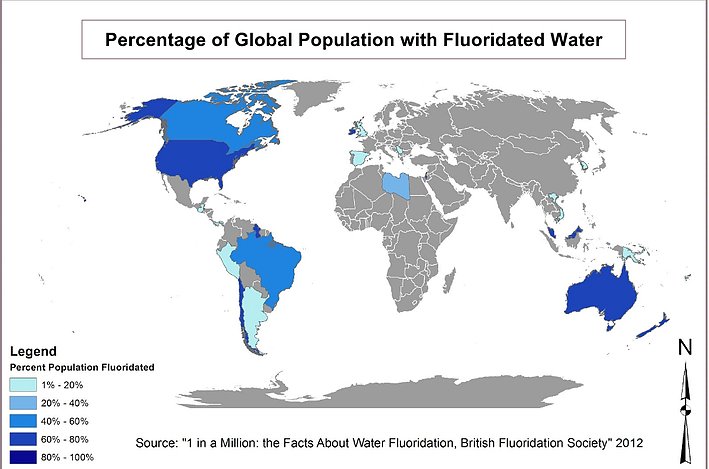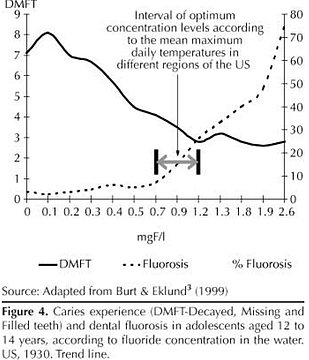 Low concentrations of fluoride (between 0.7-1.2 ppm) in drinking water have been indicated to be optimal for reducing dental decay while also minimizing incidences of dental fluorosis (United States Public Health Service). In some parts of the world (see map below), where fluoride levels are sub-optimal, artificial fluoride is added to public water sources. Communities with artificially fluoridated water supplies have a substantially lower prevalence of dental caries, and an increase with discontinuation of fluoridation (US Center for Disease Control).
Low concentrations of fluoride (between 0.7-1.2 ppm) in drinking water have been indicated to be optimal for reducing dental decay while also minimizing incidences of dental fluorosis (United States Public Health Service). In some parts of the world (see map below), where fluoride levels are sub-optimal, artificial fluoride is added to public water sources. Communities with artificially fluoridated water supplies have a substantially lower prevalence of dental caries, and an increase with discontinuation of fluoridation (US Center for Disease Control).
Fluoride Exposure
 Low concentrations of fluoride (between 0.7-1.2 ppm) in drinking water have been indicated to be optimal for reducing dental decay while also minimizing incidences of dental fluorosis (United States Public Health Service). In some parts of the world (see map below), where fluoride levels are sub-optimal, artificial fluoride is added to public water sources. Communities with artificially fluoridated water supplies have a substantially lower prevalence of dental caries, and an increase with discontinuation of fluoridation (US Center for Disease Control).
Low concentrations of fluoride (between 0.7-1.2 ppm) in drinking water have been indicated to be optimal for reducing dental decay while also minimizing incidences of dental fluorosis (United States Public Health Service). In some parts of the world (see map below), where fluoride levels are sub-optimal, artificial fluoride is added to public water sources. Communities with artificially fluoridated water supplies have a substantially lower prevalence of dental caries, and an increase with discontinuation of fluoridation (US Center for Disease Control).

Some parts of the world add low levels of fluoride to their drinking water in an attempt to promote dental health. This practice originated in the United States, and is still very present today and in many other countries around the world.
 However, above optimal levels, fluoride exposure benefits decrease and cases of fluorosis dramatically increase (see figure, right). With increased levels of fluoride concentrations in water, incidences of dental fluorosis, skeletal fluorosis, non-skeletal fluorosis, and cognitive defects may occur.
However, above optimal levels, fluoride exposure benefits decrease and cases of fluorosis dramatically increase (see figure, right). With increased levels of fluoride concentrations in water, incidences of dental fluorosis, skeletal fluorosis, non-skeletal fluorosis, and cognitive defects may occur.
Individuals can be exposed to high to extreme levels of fluoride through factory pollution and more prominently, through groundwater pollution.
